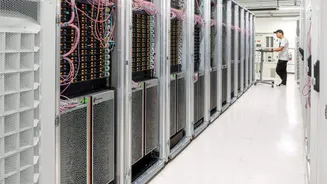The Error's Genesis
Digital systems, while appearing seamless, are prone to errors due to their complexity. These errors can arise from various sources, including software
bugs, hardware malfunctions, or network glitches. Software bugs are often the result of coding flaws that are either not identified during development or are introduced later through updates. Hardware failures, from disk drives to power supplies, also contribute to the occurrence of errors. Network-related issues, like bandwidth constraints or routing problems, can further compound the issue. External factors, such as cyberattacks or power outages, can also trigger system failures, causing considerable disruption. These varied sources emphasize the challenges of maintaining smooth digital operations.
Impact and Ramifications
When a digital system encounters an error, the consequences can be extensive. For users, it means interruption of service, potential loss of data, and frustration. Businesses face financial losses, as errors can lead to downtime, decreased productivity, and damage to their reputation. Depending on the nature of the service, the repercussions may stretch further, impacting essential services, such as healthcare, banking, or communication, causing wider societal problems. The extent of the damage varies depending on several factors, including the error's severity, the system's role, and the preparation of recovery plans. Effective management of digital failures is crucial to limit the impact and restore normal functionality.
Root Cause Analysis
Finding the root causes of digital failures often requires an in-depth analysis. This involves examining system logs, monitoring application behavior, and reproducing the error's conditions to pinpoint the original issue. Teams may conduct detailed reviews, investigating code, hardware configurations, and network settings to understand what went wrong. The process often involves several steps, from data collection and observation to error identification and analysis. Once the root cause is understood, teams can propose solutions. The goal is to correct the underlying problem and prevent future incidents. Corrective actions might include fixing software bugs, replacing faulty hardware, or implementing better security measures.
Mitigation and Prevention
Preventative measures are essential in reducing the frequency and impact of digital errors. One critical element is robust testing and quality assurance at every stage of the development process. Developers regularly test their code, from simple tests to complex integration tests. Investing in redundant hardware and reliable network infrastructure provides backup systems that prevent full outages when problems arise. Regular system monitoring helps detect potential issues before they become critical, allowing timely intervention. Additionally, implementing strict security practices minimizes the chances of external disruptions. Regularly updating software with the latest patches is crucial to fixing known vulnerabilities and improving system stability. A proactive approach to error prevention is key to reliable digital services.
Recovery Strategies
When errors do occur, a well-defined recovery strategy is essential. This often involves steps to restore the system to its operational state swiftly. Backup and restore procedures are critical, enabling the restoration of data and applications from safe copies. Developing and practicing disaster recovery plans helps businesses prepare for various scenarios, including full system failures. Automation can also speed up the recovery process by quickly deploying systems and restoring services. Communication is also essential; keeping users informed about the situation and the progress of the resolution builds trust. Post-incident reviews offer opportunities to understand what occurred, analyze the response, and identify areas for improvement in future scenarios. Effective recovery is critical to minimizing disruption and resuming operations.
Future-Proofing Systems
Building resilient digital systems for the future involves multiple strategies. Investing in scalable infrastructure enables systems to accommodate increasing demands and maintain stable performance. Implementing automated monitoring and alerting ensures teams are immediately informed of potential issues. Integrating artificial intelligence (AI) and machine learning (ML) technologies is gaining traction, providing systems with the ability to detect and automatically respond to unusual behavior. Continuous learning and adaptation, which includes staying current with new threats and techniques, enable ongoing improvement. Embracing DevOps practices, promoting quick deployment cycles, and incorporating user feedback promotes greater system reliability. The aim is to build systems that are not only robust but also capable of self-healing and evolving with the changing technological landscape.













